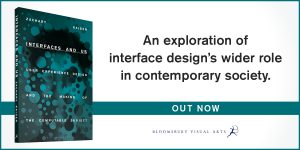Video interviews on the history of design between the Dotcom Crash and the rise of machine intelligence

As technology becomes more complex and opaque, how will we as designers understand its potential, do hands-on work, translate it into forms people can understand and use, and lead meaningful conversations with manufacturers and policymakers about its downstream implications? We are entering a new technology landscape shaped by artificial intelligence, advanced robotics and synthetic biology.
Historically, design has transformed and generated new disciplines during times of fast technological change. Through conversations led by Tellart, this project explores and documents transformations in design between the Dotcom Crash and the rise of machine intelligence. Through reflections on key projects from this period and interviews with a community of today’s top design practitioners, Design Nonfiction explores the future of design practice. It emphasises the timeless need to make the invisible visible and the immaterial tangible, in order to sketch and build with emerging technologies.
They have created four compilation videos that feature all the people mentioned below:
- The Digital Revolution [54:21]
Historically, design practice has transformed and generated new disciplines during times of fast technological change. In the early 2000s, the rapid spread of digital technologies drove designers to explore how to adapt 20th-century foundational design methods and tools to a new wave of invisible and intangible materials that promised to revolutionise material culture at every scale. - The “Immaterials” Come of Age [56:19]
The evolution of Web, mobile and social media led to the emergence of new interdisciplinary design fields and communities. Designers sought ways to sketch with hardware and software, infusing interactivity into physical products and spaces. Today’s continuing advances in Physical Computing, Augmented and Virtual Reality promise to further blend the physical and digital while offering new ways for people to experience the world and each other. - The Next Revolution [57:08]
We now enter a new technology landscape shaped by advanced robotics, machine intelligence and synthetic biology. As technology becomes even more complex and opaque, how will designers experiment with it hands-on, in order to understand its potential and give it useful and culturally relevant form? Is this simply the next technology revolution, or are we now entering uncharted territory for design? - A New Path for Design [46:54]
Design’s traditional role was to create solutions for people using appropriate tools and materials. As our social and environmental challenges grow in urgency and complexity, our tools and materials become increasingly intelligent and autonomous. Today’s designers may play a pivotal role in society by giving emerging technologies tangible form and helping people grasp the downstream implications of today’s choices – creating preferable futures for humanity and the planet.
Full interviews currently online:
- Kevin Slavin, MIT Media Lab
- Molly Wright Steenson Ph.D., Carnegie Mellon University
- Alexandra Daisy Ginsberg Ph.D., Studio Alexandra Daisy Ginsberg
- Rory Hyde Ph.D., Victoria & Albert Museum
- Aaron Koblin, Within
- Matt Jones, Google AI
- Casey Reas, Processing
- Rosanne Somerson, Rhode Island School of Design
- Zach Lieberman, openFrameworks
- Heather Dewey-Hagborg Ph.D., Bio-hacker
- Bill Verplank Ph.D, Stanford University
- Simona Maschi Ph.D, Copenhagen Institute of Interaction Design
- Robin McNicholas & Ersin Han Ersin, Marshmallow Laser Feast
- Theo Watson & Emily Gobeille, openFrameworks & Design IO
- Claire L. Evans, author
In 2020 Tellart will make full interviews available with:
- Timo Arnall Ph.D, Playdeo
- Matt Ward, Goldsmiths, University of London
- David Rose, MIT Enchanted Objects
- Zaza Zuilhof, Tellart
- Gillian Crampton Smith & Philip Tabor Ph.D., Interaction Design Institute Ivrea & Iuav University of Venice
- Stuart Candy Ph.D., School of Design at Carnegie Mellon University
- Anab Jain & Jon Ardern, Superflux
- James Bridle, artist
- Golan Levin, Carnegie Mellon University
- Mike Kuniavsky, PARC
- Jan-Christoph Zoels, Experientia
- Dan Hill, Arup
- Jack Schulze, Playdeo
- Einar Sneve Martinussen Ph.D., Oslo School of Architecture and Design
- Tom Igoe & Dan O’Sullivan, NYU ITP
- Euro Beinat Ph.D., Naspers Limited
- Sabrina Verhage, Creative Coding Amsterdam Tellart
- Nicholas Felton, Feltron
- Mimi Son & Elliot Woods, Kimchi and Chips
- Fabien Girardin Ph.D., Near Future Laboratory
- Regina Bittner Ph.D., Bauhaus Dessau Foundation
- Lavrans Løvlie, LiveWork
- Scott Smith, Changeist
- Matt Cottam & Nick Scappaticci, Tellart
- James George, Alexander Porter & Yasmin Elayat, Scatter
- Dave Gray, XPLANE
- Wendy Ju Ph.D., Cornell Tech
- Nicolas Nova Ph.D., Near Future Laboratory
- Maia Garau Ph.D., Tellart
- Julian Bleecker Ph.D., Near Future Laboratory
- Durrell Bishop, Line-us
- Alexander Chen, Google Creative Lab
- Tea Uglow, Google Creative Lab
- Ben Cerveny, The Foundation for Public Code
- Matt Cottam & Jan-Christoph Zoels, Tellart & Experientia
Design Nonfiction is funded and produced independently by Tellart. The video media are available for free download and distribution through the Creative Commons Attribution-NonCommercial-NoDerivatives 4.0 license.



